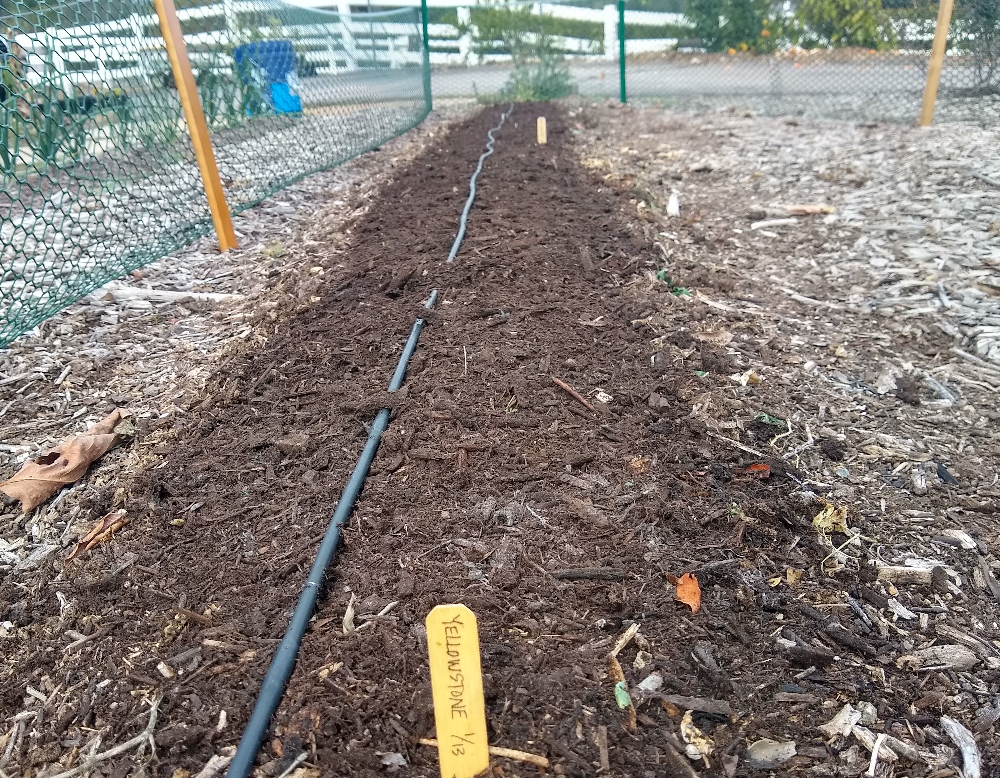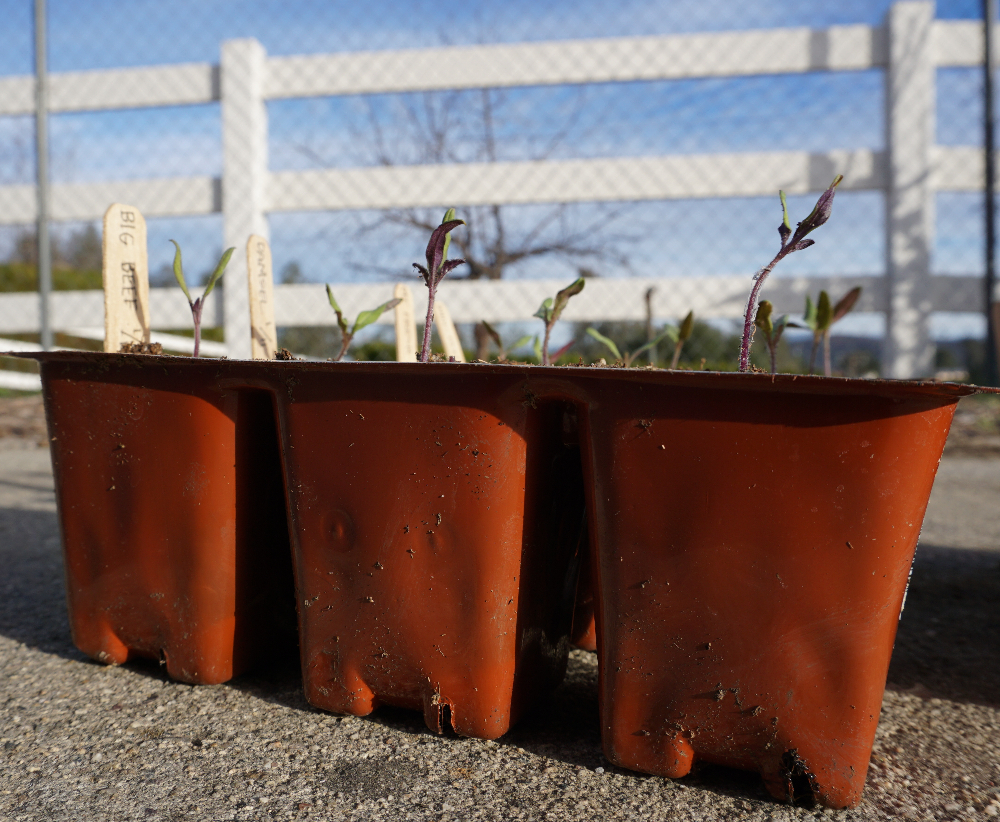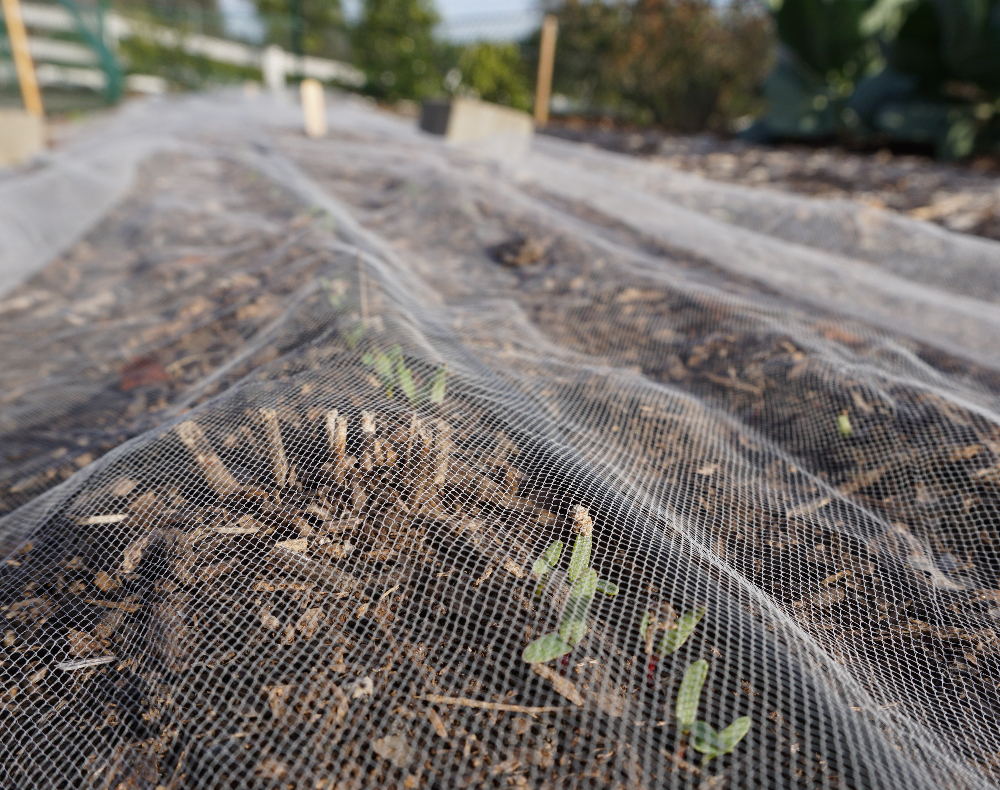Upon reflection, if my vegetable seeds germinate fast and grow into strong seedlings, it’s because I’ve done things right in six specific areas. Here I note what to do and what not to do in these areas so that I don’t repeat mistakes, and so you never make them in the first place.
Temperature
To an extent, the warmer the dirt, the faster the vegetable seed germinates. This goes for crops that like to grow in winter as well as those which like to grow in summer.
For example, although carrots grow best in cool soil, they germinate fastest in warm soil (around 75 degrees is optimal in terms of speed). I’ve seen this as I’ve kept records of germination times of carrot sowings in different seasons.
The practical take-away here is that you can know what to expect when you sow seeds according to how warm is the soil or medium in which they are sown. Don’t expect carrots to emerge in only a few days when you sow them in chilly, wet January dirt. But in September, expect them to be up and growing within a week.
And you can manipulate how fast your seeds sprout by warming them up. A few weeks ago I sowed broccoli seeds in module trays where some had bottom heat and some did not. Those over the heat germinated in 3-4 days. Those without heat took twice as long to germinate.
Depth
Beware of sowing too deeply. That’s the mistake I’ve personally made the most. Sowing vegetable seeds doesn’t mean burying them, it means just lightly covering them so that they don’t dry out quickly.
In fact, small seeds like lettuce don’t need to be completely covered at all. When sowing lettuce nowadays, I sprinkle the seed and then sprinkle a dusting of compost over the top. Some of the seeds are still showing.
The smaller the seed, the more shallowly it should be covered. If covered too deeply, the seed will never emerge.
I find it helpful to remember what happens in nature. Think of a wild mustard plant, which is very similar to our garden broccoli and kale plants.
The mustard flowers and forms seed pods, and then the seed pods dry and split open. The tiny black balls (seeds) rain onto the ground. The plant dies down and its parts partially cover the seeds. No one digs a hole and buries them under the dirt. Dead plant bits simply cover the seeds, partially. Then the fall rains arrive and the seeds grow.
Medium
If you’re starting seeds in containers rather than in the ground or in a raised bed, then you can use purchased seed-starting mixes, compost, or straight garden dirt. I’ve used them all; you can start vegetable seeds in them all.
However, starting vegetable seeds in purchased mixes is more forgiving. Compost can contain weed seeds and can be salty, depending on what it’s made from. Dirt can form a crust on the surface, which is hard for sprouting seeds to break through. All three can work, but a purchased mix usually brings more reliable results unless you know the quirks of your particular compost or dirt.
(Check out this post: “Comparing my compost and Recipe 420 for starting vegetable seeds.”)
Sun
While plants need sunlight to grow, seeds do not need sunlight to start growing. (Even those that are said to, such as certain types of lettuce, don’t need anywhere near full sunlight.)
Therefore, the best place to put your containers is usually in some amount of shade because it’s easier to keep the mix moist when the sun is not evaporating water from it all day. I usually keep my containers in my garage, which has a few windows.
(See my post, “Starting brassicas in summer.”)
But immediately upon germination, you must get those babies into a lot of sun. Now they’re plants, and they will grow best in all day full sun during the cooler times of year, and possibly with only light shade during late spring and summer. I often use 30 percent shade cloth over seedlings during this season.
If the seedlings are not in strong enough sun, they grow tall and have weak stems and start falling over. They’re stretching to try to find more sun.
Water
Most vegetable seeds need only two requirements met in order to start growing. They need the temperature to be within a certain range, and they need to remain moist for a certain period of time. That’s it.
Note that I said moist, not wet. What most seeds want is water to imbibe at first, and then merely protection from drying out quickly. They don’t want to stay soaked for long.
Again, think of nature. It rains and the seeds are soaked. They drink up the necessary water. But then the sun comes out and the dirt dries a little before another rain.
Similarly, you soak the ground or the sowing mix at the time of starting the seeds (soaking before sowing is best), but then you don’t necessarily keep watering it every day.
How to tell if it’s time to add some water? I use two methods: touch and lift. Wet soil is sticky. Does it feel sticky? Then it’s wet; don’t water.
And wet soil is heavy because water is heavy. Does the tray or container feel heavy? If so, don’t yet add water.
Of course, wet soil is also darker so your eyes can help too.
Why not water too much? It can rot the seeds and lead to diseases such as “damping off.”
Birds
Birds will scratch the ground and the mix in your containers to find your seeds. I most often see towhees and white-crowned sparrows doing this damage in my garden. They’ll also nip the first leaves off as soon as the seedlings sprout. It’s therefore wise to protect the seeds and seedlings.
Other posts you might like:
“Can you start vegetable seeds in compost?”
“Should you grow vegetables from seeds or plants?”
“Easiest vegetables to grow from seed”
A good book I own about seed-saving and seed-starting: ”The Complete Guide to Saving Seeds” by R. Gough and C. Moore-Gough.
All of my Yard Posts are listed HERE








Please add me to your list. For some reason I stopped getting your blog post emails and I miss them. Thanks.
Thanks for sharing your observations, Greg. I’ve had very good success germinating my seeds in cool soil by covering the seeds with black plastic for a week to 10 days. It both warms the soil when the sun hits it and keeps the soil moist. I anchor it down with u-shaped spikes that are normally used for those plastic tunnel coldframes and check it every few days after the first week. Once the green starts to show, I remove the plastic.
really nice to have all this info pulled together! many of us have probably read some on how soil temp affects germination…but do we follow the advice? 🙂 Maybe not if you’re like me and always wanting to see things grow! So I plant too early, in soil that is too cool, LOL. Thanks for the solid reminder!
Hi Greg,
Hope you are doing well. I think I had asked you this a few years ago on another comment but I can’t find it 🙁 sorry.
I was wondering if you had any advice on what to do with seedlings that are in seed starting trays during this upcoming week of intense heat. It’s going to be around a max of 98/99 where I’m at so it’s not (fingers crossed) going to get to the 110/115 I’ve been hearing about in other parts of cali.
Should I bring my seed trays inside? Should I leave them outside in shade?
I have some beans and basil and lots of brassicas and some peas that I started about 2 weeks ago and some are barely poking out of their cells and some are about an inch high and some are a quarter inch. I already had a few lettuce seedlings basically give up and die so am wondering what to do.
And given this max temp, would you still recommend shading tomatoes and small (4-6 foot) avocado trees? I’ve been bringing any tomatoes that are starting to turn color into the house to ripen on the counter to protect from the heat and also from the critters. What about other fruit trees that are in pots that I was hoping to start putting into the ground this weekend (peaches, nectarines, Nectaplum, bananas, cherries, mandarins, oranges, a fig, pomegranate, apples and 2 guavas). Would you recommend shading any of them? Should I hold off on starting to put them in? I was going to start with the 2 avocados and follow your advice on watering, planting, etc. but am wondering if I should now.
Thanks in advance for your reply and advice!
MB
Hi MB,
In those temps I cover veg seedlings with 30-60 percent shade cloth if in all-day sun or no shade cloth but place them where they’ll get shade from a tree or building after about noon.
The avocados don’t need shade at those temps, but if you’re afraid you can’t be on top of the watering it would help to add shade for the midday hours.
Tomato fruit will get scalded at those temps if they’re not covered by leaves, even the young green ones, especially the big-fruited types. I would cover them. I use 30 percent in those temps.
No other fruit trees should need shade.
However, if they’re in pots it can help to shade the south and west sides of the pots, which can heat up so much as to kill roots on those sides. Group the trees together, paint the containers, wrap in shade cloth . . . there are lots of good ways to do it.
If you can be on top of the watering, put the trees (including avocados) in the ground now. I’ve planted when 100 degrees successfully as long as I’ve gotten the trees water on time all the time in the first month. Otherwise, wait a few days for this heat to subside. No rush. Might as well just wait.
Best wishes with the new plantings!
Thanks Greg! This is great advice. I’m going to save this in my notes so I find it the next time we get high temps here.
I was thinking of sowing some carrot seeds to try to take advantage of the heat. Let’s see how that works out. I’m also tempted to sow some sunflower seeds directly into the ground to see if I can get some to flower. We will see 🙂
Thanks again!
-MB